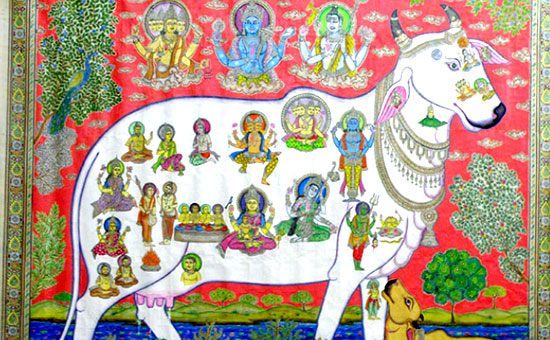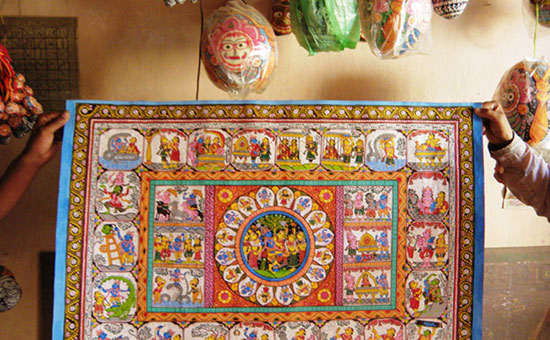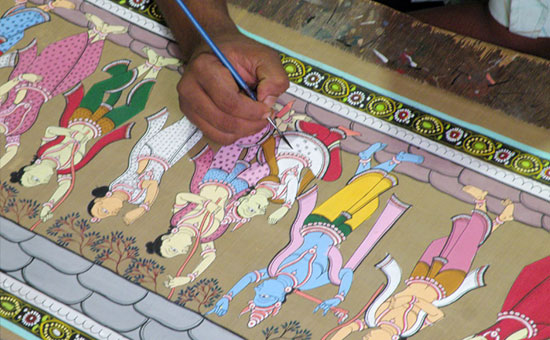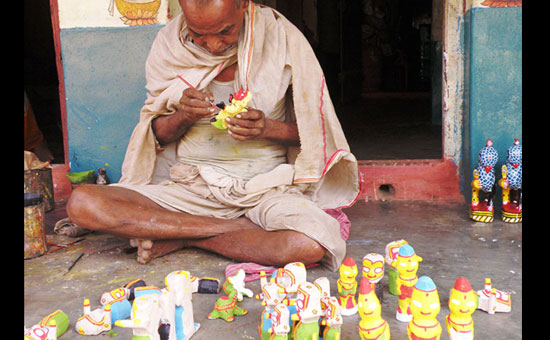-
Article
tells you about the origin of Pattachitra paintings, its meaning, evolution and
style along with recent innovations. Lastly, how is the painting done.
Pattachitra
art form is known for its intricate details as well as mythological narratives
and folktales inscribed in it. Some of the popular themes represented through
this art form are Thia Badhia - depiction of the temple of Jagannath; Krishna
Lila - enactment of Jagannath as Lord Krishna displaying his powers as a child;
Panchamukhi - depiction of Lord Ganesh as a five-headed deity.
This
old tradition of Odia painting still survives in places like Puri, Raghurajpur,
Paralakhemundi, Chikiti and Sonepur.
Origin
The paintings of Orissa can be divided into three categories from the point of view of medium, i.e. paintings on cloth or 'Patta Chitra', paintings on walls or 'Bhitti Chitra' and palm leaf engravings or "Tala Patra Chitra' or "Pothi, Chitra'. The style of all these remains more or less the same at a specific time because the then artists were commissioned to work in all these media, it is believed.
The painting the 'pattachitra' resemble the old murals of Odisha especially religious centres of Puri, Konark and Bhubaneshwar region, dating back to the 5th century BC. The best work is found in and around Puri, especially in the village of Raghurajpur.
 Painting village Raghurajpur.
Painting village Raghurajpur.
History
The
oldest record of Patta Paintings does not probably go beyond the establishment
of the present shrine of Shri Jagannath Mandir, Puri. It may be due to the fact
that paintings do not survive like sculptures. The paints inside the shrines of
Lord Jagannath at Puri make the date probable.
The
oldest classical marble paintings of Sitabanji at Keonjhar do not conform to
the present style of Patta painting wholly. The wooden statues of the three
deities are also covered with cloth and then overlaid with glue mixed with
chalk, and then given paint only with four limited colours of red, yellow,
white and black.
The
deities who are held in high esteem by the Odias and who inspire religion, life
and activity of the people also carry with them a tradition of art and painting
which is as old as the deities themselves. If the Savara origin of Jagannath is
accepted, the date of the Patta paintings can be dated back to an earlier
period.
What does it mean?
Pattachitra evolved
from Sanskrit. When broken down into its two parts, Patta means
cloth, and Chitra means picture. Hence, Pattachitra is a
picture painted on a piece of cloth.
This
form of art is closely related to the worship of Shri Jagannath and the temple
traditions in Puri. It is believed to have originated as early as the 12th
century, is one of the most popular living art forms, and people in Odisha
practice it to this day.
Almost
all of the Chitrakar community hails from a small village in Puri district
called Raghurajpur. This is also the only village in India where each
family is engaged in crafts, such as patta painting, wooden toys, stone
carvings, etc.
 Painting inside
home at Raghurajpur.
Painting inside
home at Raghurajpur.
For
Pattachitra painting, the Chitrakars follow a traditional process of preparing
the canvas. A gauze-like fine cotton cloth is coated with white stone powder and
gum made out of tamarind seeds. This makes the canvas ready to accept the
paint, made of natural colors.
These
colors are a unique feature of Pattachitra. The gum of the kaitha tree is the
chief ingredient, used as a base for making different pigments by adding
available raw materials. For instance, to get the shade of white, powdered
conch shells are used.
Icon Painting
Pattachitra
is predominantly icon painting. Some of the popular themes of this art are The
Badhia (a depiction of the temple of Jagannath); Krishna Lila (an enactment of
Jagannath as Lord Krishna displaying his powers as a child); Dasabatara Patti
(the ten incarnations of Lord Vishnu); and Panchamukhi (a depiction of Lord
Ganesh as a five-headed deity).
Every
year, during Debasnana Purnima in
Puri Jagannath Temple, the deities are believed to take a bath with 108 pots of
cold water to fight the heat of summer.
Afterwards, the deities supposedly fall sick for a period of 15 days known as ‘Anasara.’ Because of the deities’ absence from public view, some of the finest Chitrakars are gathered to make three Pattachita paintings of the three deities - namely Lord Jagannath, Goddess Subhadra, and Lord Balabhadra - for the public to pay obeisance. These painting are called Anasar Patti.
It
is a disciplined form of art with a set of rules and restrictions. A floral
border is a must around the paintings, and so is the use of natural colors. The
paintings are executed primarily in profile with elongated eyes, as well. With
the use of such prominent solid shades, the paintings end up depicting stark
emotional expressions with great detail. Following completion of a painting,
the canvas is held over a charcoal fire and lacquer is applied to the surface.
Evolution
Over
the years the art form has evolved and has experienced discernible changes. The
Chitrakars have painted on palm leaves and Tussar silk and have also
created wall hangings and showpieces. Because of the stringent methodology of
the art, it survives, preserving the effervescence of the aesthetic
Pattachitra. The intriguing folk paintings are internationally known, and the
setting up of centres to teach the art form in Odisha speaks volumes about its consistency
and popularity.
 Wall hanging painting
in progress.
Wall hanging painting
in progress.
The two traditions that greatly patronized this craft were the Jagannath’s and Vaishnava’s. The basic Pattachitra tales revolved around their beliefs and traditions.
Indian
gods such as Krishna, Vishnu, Shiva, Hanuman, and goddesses such as Radha, Parvati
and Sita were the main images used to depict tales and stories which were
related to Hindu scriptures and texts.
Apart
from Orissa, this artwork is also widely practiced in West Bengal. The only
difference is that in Orissa, pattachitra art is done on Cotton fabric,
whereas Silk is mostly used in Bengal.
Style
Patachitra
style of painting is a unique blend of classical and folk element but is more
bent towards a folk style in the larger sense.
What is even more interesting is that this artwork has Mughal influences as well when it comes to the character’s apparel and fashion sense. Features of each character are defined with clear dark lines which give a definite shape and appeal. Natural dyes and colors are used, all of which are derived from fruits and vegetables.
Painting
themes may be classified into following categories:
Jagannath, Vaishnav, Bhagavat, Ramayana, Saiva, Shakta, Ragachitras, Bandhachitra, Yamapati and yatripatas – (sketches of Puri temple) Ganjapa playing card paintings and other socials.
 Painting by artist Raghurajpur
Painting by artist Raghurajpur
Surfaces
The
pattachitra, when painted on cloth, follows a traditional process of
preparation of the canvas.
First,
the base is prepared by coating the cloth with the soft, white, stone powder of
chalk and glue made from tamarind seeds. This gives the cloth tensile strength
and a smooth, semi-absorbent surface, allowing it to accept the paint. The
artist does not use a pencil or charcoal for the preliminary drawings. It is a
tradition to complete the borders of the painting first. The painter then
starts making a rough sketch directly with the brush using light red and
yellow. The main flat colours are applied next; the colours used are normally
white, red, yellow, and black.
The
painter then finishes the painting with fine stokes of black brush lines,
giving the effect of pen work. When the painting is completed it is held over a
charcoal fire and lacquer is applied to the surface. This makes the painting
water resistant and durable, besides giving it a shining finish.
The materials used in the paint are from vegetable, earth, and
mineral sources.
Black is made out of lampblack, yellow from haritali stone, and red from hingal
stone. White is prepared from crushed, boiled, and filtered shells.
The
subject matter of the pattachitras includes cultural, and folk themes. Krishna
Leela and Lord Jagannath are important motifs.
Palm
leaf pattachitra, which is in Oriya language known as Tala
Pattachithra, is drawn on palm leaf.
First
of all palm leaves are left for becoming hard after being taken from tree. Then
these are sewn together to form like a canvas. The images are traced by using
black or white ink to fill grooves etched on rows of equal-sized panels of palm
leaf that are sewn together. These panels can also be easily folded like a fan
and packed in a compact pile for better conservation. Often palm-leaf
illustrations are more elaborated, obtaining by superimposing layers that are
glued together for most of the surface, but in some areas can open like small
windows to reveal a second image under the first layer.
Innovations
Apart
from paintings, pattachitra artwork is also widely used on Cotton, Silk
and Georgette saris.
Quirky,
unique and a refreshing appeal from the traditional saris, pattachitra artwork
lends a different sense of ethnic fashion to the 9-yard apparel. Bright hues
such as red, pink, purple, yellow, green and white are used to adorn classic
saris which add a vibrant twist to the epic tales that are narrated on the sari
pallus or borders.
Apart
from saris, pattachitra art has become rampant with household accessories as
well which includes ceramic bowls, pens, coasters, plates, wall hangings, key
chains, and boxes as well.
Currently,
several designers and craftsman have come up with quirky ways of introducing
this artwork on large handbags and totes, t-shirts, skirts, jeans, belts
and even on stationary!
Author is a Mumbai based artist. The
purpose of this compilation is to document and promote. We have given credits
and reference links in this compilation. In case some are missed, it is not
with malafide intent.
To read all
articles by author
To see album of
1.
Pattachitra
Paintings a heritage village Raghurajpur near Puri. Captions have names and phone numbers, email ids of artists. For local contact call Pranab Das 91 97769 24900, 91 94376 32111, 91 70086 18651. He is a painter, sells paintings and is from Raghurajpur so can take you around the village. He took me around and did a good job.
All
pictures courtesy Sanjeev Nayyar from the above album of Raghurajpur.